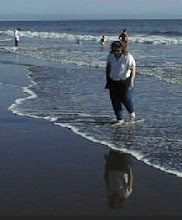 You will need:
You will need:Your choice of wire
Wire cutters
Round nosed pliers
Bent/flat nosed pliers
1. Start by bending the wire to a 90 degree angle so that you create an upside down L shape.
2. Hold the bend with your round nosed pliers, and use your fingers to wrap the wire around the nose of your pliers to form a loop.

3. Keep the round nosed pliers inside the loop, and hold the loop against the nose of the pliers with one finger. So, you should have your round nosed pliers in one hand with one finger pressing the loop against the nose. (I'm right handed, so I use my left hand to hold the pliers and my pointer finger to hold the loop against the nose.)
4. Using your other hand (in my case, my right hand), start to wrap the loose wire around the straight piece of wire that is directly under your loop. If the wire is soft, you can probably do this with your fingers. Otherwise, use a bent (of flat if you prefer) pair of pliers to hold the loose wire and wrap.
 5. Continue to wrap as many times as you want, and if necessary, trim off excess wire.
5. Continue to wrap as many times as you want, and if necessary, trim off excess wire.
 6. Use your bent nosed pliers to press the wire wrapped end flat to make sure it doesn't stick our and scratch or poke the wearer of your jewelry.
6. Use your bent nosed pliers to press the wire wrapped end flat to make sure it doesn't stick our and scratch or poke the wearer of your jewelry.
7. If necessary, use your round nose pliers to straighten the loop.
A Few Tips:
- Be patient, and be prepared to practice. There is no way you will do this perfectly the first time. The more you do it, the better you will become.
- Be careful not to wrap too close to a bead if you are including one on the wire as it could crack the bead. Though some jewelry makers like to get their wrap as close as possible to the bead, I don't mind a little room, but this is personal preference.
- For beads with small holes, like pearls, you will need thin wire such as 24-28 gauge. Otherwise, 21 gauge seems to work will with most bead sizes.
- When making long, loop wrapped chains, instead of cutting lots of small pieces of wire for each loop, try using longer pieces (about a foot or so in length), and cutting the wire after each loop is made. This will keep wire waste down.
All graphics and lessons created by Tammy Powley.



